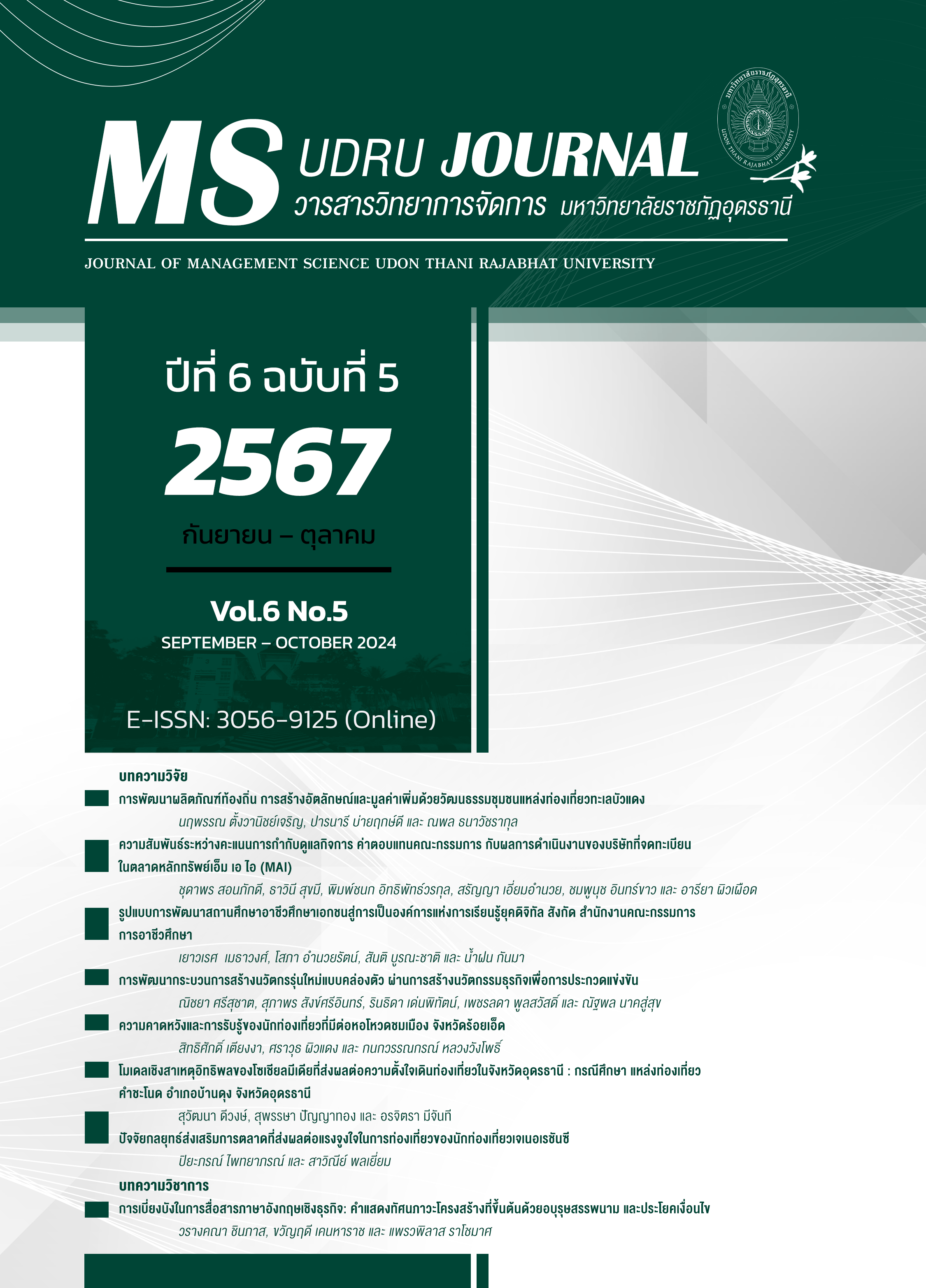โมเดลเชิงสาเหตุอิทธิพลของโซเชียลมีเดียที่ส่งผลต่อความตั้งใจเดินท่องเที่ยวในจังหวัดอุดรธานี: กรณีศึกษา แหล่งท่องเที่ยวคำชะโนด อำเภอบ้านดุง จังหวัดอุดรธานี
Main Article Content
บทคัดย่อ
การศึกษาในครั้งนี้ มีวัตถุประสงค์เพื่อศึกษาอิทธิพลของคุณภาพข้อคิดเห็น การมีส่วนร่วมของผู้ชม และการรับรู้ภาพลักษณ์แหล่งท่องเที่ยว ที่มีต่อความตั้งใจเดินท่องเที่ยวในจังหวัดอุดรธานี โดยเก็บรวบรวมข้อมูลด้วยแบบสอบถามจากกลุ่มตัวอย่างเป็นนักท่องเที่ยวที่เคยมีประสบการณ์ดู เห็น ฟัง หรืออ่านสื่อเกี่ยวกับแหล่งท่องเที่ยวคำชะโนดผ่านโซเชียลมีเดีย จำนวน 280 คน ด้วยวิธีการสุ่มแบบบังเอิญ วิเคราะห์ข้อมูลด้วยสถิติเชิงพรรณนา และการวิเคราะห์โมเดลสมการเชิงโครงสร้าง พบว่า โมเดลมีความสอดคล้องกับข้อมูลเชิงประจักษ์ โดยความตั้งใจเดินทางท่องเที่ยว ได้รับอิทธิพลทางตรงเชิงบวกจากการรับรู้ภาพลักษณ์แหล่งท่องเที่ยว นอกจากนี้ยังได้รับอิทธิพลทางอ้อมเชิงบวกจากคุณภาพข้อคิดเห็น และการมีส่วนร่วมของผู้ชม ตามลำดับ โดยตัวแปรทำนายร่วมกันอธิบายความแปรปรวนของความตั้งใจเดินทางท่องเที่ยวได้ร้อยละ 74
Article Details

อนุญาตภายใต้เงื่อนไข Creative Commons Attribution-NonCommercial-NoDerivatives 4.0 International License.
บทความที่ได้รับการตีพิมพ์เป็นลิขสิทธิ์ของคณะวิทยาการจัดการ มหาวิทยาลัยราชภัฏอุดรธานี
ข้อความที่ปรากฏในบทความแต่ละเรื่องในวารสารวิชาการเล่มนี้
ไม่ใช่ความคิดเห็นและความรับผิดชอบของผู้จัดทำ บรรณาธิการ กองบรรณาธิการ และคณะวิทยาการจัดการ มหาวิทยาลัยราชภัฏอุดรธานี ความรับผิดชอบด้านเนื้อหาและการตรวจร่างบทความแต่ละเรื่องเป็นความคิดเห็นของผู้เขียนบทความแต่ละท่าน
เอกสารอ้างอิง
ณพวัศกช์ เดชชาตรี, กฤตติกา แสนโภชน์, อรุณศรี อื้อศรีวงศ์ และ ธนกฤต ทุริสุทธิ์. (2560). ยุทธศาสตร์การจัดการแหล่งท่องเที่ยวในพื้นที่ศักดิ์สิทธิ์คำชะโนด อำเภอบ้านดุง จังหวัดอุดรธานี. วารสารมนุษยศาสตร์สังคมศาสตร์ มหาวิทยาลัยขอนแก่น, 34(3), 224-246.
ประสพชัย พสุนนท์. (2558). ความเที่ยงตรงของแบบสอบถามสำหรับงานวิจัยทางสังคมศาสตร์. วารสารสังคมศาสตร์ มหาวิทยาลัยศรีนครินทรวิโรฒ, 18(มกราคม – ธันวาคม), 375-396.
วีระ วีระโสภณ. (2567). ปัจจัยที่ส่งผลต่อระดับความพึงพอใจและระดับความตั้งใจในการเดินทางกลับมาเที่ยวประเทศญี่ปุ่นอีกครั้งของนักท่องเที่ยวชาวไทยในเขตกรุงเทพมหานคร. สหวิทยาการและความยั่งยืนปริทรรศน์ไทย, 13(2), 288-297.
อรสา เตติวัฒน์ และ วัชราภรณ์ อิสิชัยกุล. (2559). รายงานวิจัยฉบับสมบูรณ์ โครงการย่อยที่ 3 การตลาดทางสื่อสังคมออนไลน์เพื่อส่งเสริมการท่องเที่ยวเชิงนิเวศในประเทศไทย. กรุงเทพฯ: สำนักงานกองทุนสนับสนุนการวิจัย.
Beeton, S. (2008). From the screen to the field: the influence of film on tourism and recreation. Tourism Recreation Research, 33(1), 39–47.
Bentler, P. M., & Chou, C. P. (1987). Practical Issues in Structural Modeling. Sociological Methods & Research, 16(1), 78–117.
Bhattacherjee, A., & Sanford, C. (2006). Influence processes for information technology acceptance: an elaboration likelihood mode. MIS Quarterly, 30(4), 805–825.
Chen, C. W., Chen, W. C., & Chen, W. K. (2014). Understanding the effects of eWOM on cosmetic consumer behavioral intention. International Journal Electronic Commerce Studies, 5(1), 97–102.
Cheung, C. M. K., Lee, M. K. O., & Rabjohn, N. (2008). The impact of electronic word-of-mouth: the adoption of online opinions in online customer communities. Internet Research, 18(3), 229–247.
Cheung, R. (2014). The influence of electronic word-of-mouth on information adoption in online customer communities. Global Economic Review, 43(1), 42–57.
Cortina, J. M. (1993). What is Coefficient Alpha: An Examination of Theory and Applications? Journal of Applied Psychology, 78(1), 98-104.
Diamantopoulos, A., & Siguaw, J. A., (2000). Introduction to LISREL: A guide for the uninitiated. London: SAGE Publications.
Eder, J., Smith, W. W., & Pitts, R. E. (2010). Exploring factors influencing student study abroad destination choice. Journal of Teaching in Travel & Tourism, 10(3), 232–250.
Erkan, I., & Evans, C. (2016). The influence of eWOM in social media on consumers’ purchase intentions: An extended approach to information adoption. Computers in Human Behavior, 61, 47–55.
Fornell, C., & Larcker, D. F. (1981). Evaluating Structural Equation Models with Unobservable Variables and Measurement Error. Journal of Marketing Research, 18(1), 39–50.
Fu, H., Ye, B. H., & Xiang, J. (2016). Reality TV, audience travel intentions, and destination image. Tourism Management, 55, 37–48.
Gunawan, D. D., & Huarng, K.-H. (2015). Viral effects of social network and media on consumers’ purchase intention. Journal of Business Research, 68(11), 2237–2241.
Hair, J. F., Black, W. C., Babin, B. J., & Anderson, R. E. (2014). Multivariate Data Analysis. (7th Ed.). Harlow, United Kingdom: Pearson Education.
John, S. P., & De’Villiers, R. (2020). Elaboration of marketing communication through visual media: An empirical analysis. Journal of Retailing and Consumer Services, 54, 102052, doi.org/10.1016/j.jretconser.2020.102052.
John, S., Larke, R., & Kilgour, M. (2018). Applications of social media for medical tourism marketing: an empirical analysis. Anatolia. https://doi.org/10.1080/13032917.2018.1473261.
Kline, R. B. (2011). Principles and Practice of Structural Equation Modeling. (3rd Ed.). New York: Guilford.
Park, S. H., Hsieh, C. M., & Lee, C. K. (2017). Examining Chinese college students’ intention to travel to Japan using the extended theory of planned behavior: testing destination image and the mediating role of travel constraints. Journal of Travel & Tourism. Marketing, 34(1), 113–131.
Patino, A., Kaltcheva, V. D., & Smith, M. F. (2011). The appeal of reality television for teen and pre-teen audiences: the power of connectedness and psycho-demographics. Journal Advertising Research, 51(1), 288–298.
Petty, R. E. & Cacioppo, J. T. (1986) The elaboration likelihood model of persuasion. Advances in Experimental Social Psychology, 19, 123–205.
Petty, R. E., Cacioppo, J. T., & Schumann, D. (1983). Central and peripheral routes to advertising effectiveness: The moderating role of involvement. Journal of Consumer Research, 10(2), 135–146.
Schumacker, R. E., & Lomax, R. G. (2010). A Beginner’s Guide to Structural Equation Modeling. (3rd Ed.). New Jersey: Lawrence Erlbaum.
Suni, J., & Komppula, R. (2012). SF-filmvillage as a movie tourism destination—a case study of movie tourist push motivations. Journal of Travel & Tourism. Marketing, 29(5), 460–471.
Sussman, S. W., & Siegal, W. S. (2003). Informational influence in organizations: An integrated approach to knowledge adoption. Information Systems Research, 14(1), 47–65.
Wang, P. (2015). Exploring the influence of electronic word-of-mouth on tourists’ visit intention. Journal of Systems and Information Technology, 17(4), 381–395.


